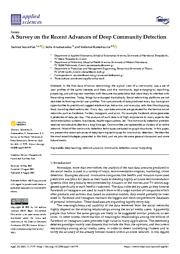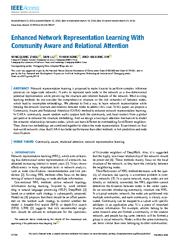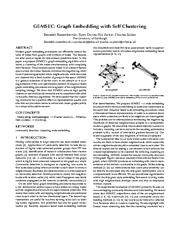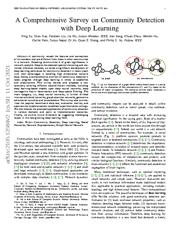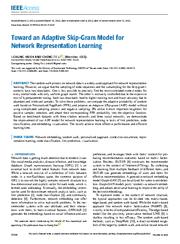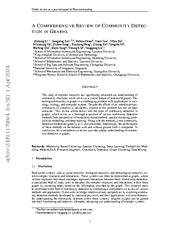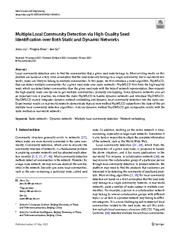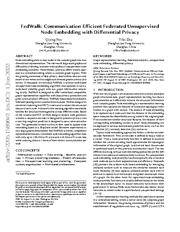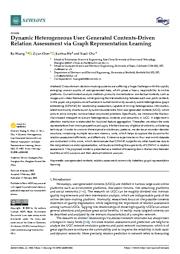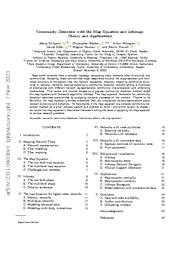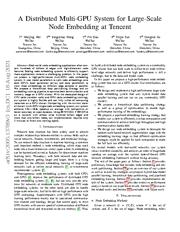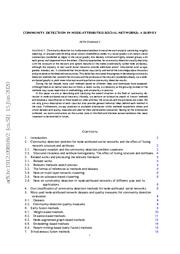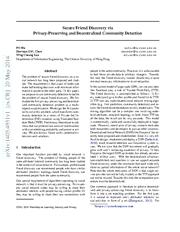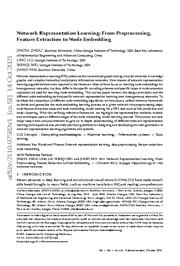A copy of this work was available on the public web and has been preserved in the Wayback Machine. The capture dates from 2021; you can also visit the original URL.
The file type is application/pdf.
Filters
A Survey on the Recent Advances of Deep Community Detection
2021
Applied Sciences
Most of the community detection techniques are based on graph structures. In this paper, we present the recent advances of deep learning techniques for community detection. ...
Every day, vast data amounts are generated by the famous social networks such as Facebook, Twitter, Instagram, and so on. For example, Facebook alone generates 4 petabytes of data per day. ...
In [51] , a scheme based on learning ground-truth communities for community detection over large networks is introduced. ...
doi:10.3390/app11167179
fatcat:lzff6bskjrfgfo5ho7dalltke4
Enhanced Network Representation Learning with Community Aware and Relational Attention
2020
IEEE Access
In CARA, community aware random walks capture both the community and local context from a global perspective to enhance the structure embedding. ...
In this paper, we propose a Community Aware and Relational Attention (CARA) method to enhance network representation learning. ...
between nodes to enhance network representation learning for different types of information: community, local structure and text information. • We define a new community aware random walk considering ...
doi:10.1109/access.2020.2981649
fatcat:elpbyxwt3jbefouebw7vgh2kxa
GEMSEC: Graph Embedding with Self Clustering
[article]
2019
arXiv
pre-print
with or superior to other community detection algorithms. ...
We present two new social network datasets and show that by simultaneously considering the embedding and clustering problems with respect to social properties, GEMSEC extracts high-quality clusters competitive ...
ACKNOWLEDGMENTS Benedek Rozemberczki and Ryan Davies were supported by the Centre for Doctoral Training in Data Science, funded by EPSRC (grant EP/L016427/1). ...
arXiv:1802.03997v3
fatcat:mxx7qi7qzffknd34d5qd4kofhe
A Comprehensive Survey on Community Detection with Deep Learning
[article]
2021
arXiv
pre-print
Despite the classical spectral clustering and statistical inference methods, we notice a significant development of deep learning techniques for community detection in recent years with their advantages ...
A community reveals the features and connections of its members that are different from those in other communities in a network. Detecting communities is of great significance in network analysis. ...
Random walks are utilized to detect communities dynamically. For example, the random walk in WalkTrap [45] calculates node distances and the probability of community membership. ...
arXiv:2105.12584v2
fatcat:matipshxnzcdloygrcrwx2sxr4
Big networks: A survey
2020
Computer Science Review
Some typical applications in big networks are then reviewed, such as community detection, link prediction, recommendation, etc. ...
Big networks are generally in large-scale with a complicated and higher-order inner structure. ...
Random-walk-based Community Detection Methods Among all community detection approaches, random-walk based methods inclined to discover network communities more or less accurate with the groundtruth ones ...
doi:10.1016/j.cosrev.2020.100247
fatcat:pmuxvvbprnc4jcy3gqmrjyf4tq
Towards an Adaptive Skip-gram Model for Network Representation Learning
2022
IEEE Access
The random walk process on network data is a widely-used approach for network representation learning. ...
Based on benchmark datasets with three citation networks and three social networks, we demonstrate the improvement of our ASK model for network representation learning in tasks of link prediction, node ...
The proposed Adaptive SKip-gram model can be seamlessly used for random walk Skip-gram based network representation learning models, such as node2vec and DeepWalk so that the efficiency and the effectiveness ...
doi:10.1109/access.2022.3164670
fatcat:3doknonthfecpev6un7ydwlpxy
A Comprehensive Review of Community Detection in Graphs
[article]
2024
arXiv
pre-print
clustering, probabilistic modelling, and deep learning. ...
Along with the methods, a new community detection method designed by us is also presented. Additionally, the performance of these methods on the datasets with and without ground truth is compared. ...
Highway Transportation Innovation Consortium, and the project name is Gansu Province Green and Smart Highway Key Technology Research and Demonstration. ...
arXiv:2309.11798v4
fatcat:vu3skmbwuncixlufd3jmfmc4xa
Multiple Local Community Detection via High-Quality Seed Identification over Both Static and Dynamic Networks
2021
Data Science and Engineering
HqsDMLCD mainly integrates dynamic network embedding and dynamic local community detection into the static one. ...
HqsMLCD first finds the high-quality seeds which can detect better communities than the given seed node with the help of network representation, then expands the high-quality seeds one-by-one to get multiple ...
U1936104) and The Fundamental Research Funds for the Central Universities 2020RC25. ...
doi:10.1007/s41019-021-00160-6
fatcat:6drxrrmgcvb6tltyrrfyjnyqmy
FedWalk: Communication Efficient Federated Unsupervised Node Embedding with Differential Privacy
[article]
2022
arXiv
pre-print
The generated random walks are then used to update node embedding based on a SkipGram model. ...
Based on the constructed HCT, we then design a random walk generator, wherein a sequence encoder is designed to preserve privacy and a two-hop neighbor predictor is designed to save communication cost. ...
used to learn vector representations for nodes. ...
arXiv:2205.15896v2
fatcat:jwixjzelwnb4zpki5yadkuiode
Dynamic Heterogeneous User Generated Contents-Driven Relation Assessment via Graph Representation Learning
2022
Sensors
In this paper, we propose a novel framework named community-aware dynamic heterogeneous graph embedding (CDHNE) for relationship assessment, capable of mining heterogeneous information, latent community ...
Specifically, we introduce the Markov-chain-based metapath to extract heterogeneous contents and semantics in UGC. A edge-centric attention mechanism is elaborated for localized feature aggregation. ...
However, most graph representation learning methods focus on the topological properties of nodes (e.g., in-degree or out-degree, random walk distance, first-order proximity and so on). ...
doi:10.3390/s22041402
pmid:35214304
pmcid:PMC8963052
fatcat:h5553hhrkjh3nnnlavy7k6trmq
Community Detection with the Map Equation and Infomap: Theory and Applications
[article]
2023
arXiv
pre-print
The map equation framework for community detection describes communities by analyzing dynamic processes on the network. ...
However, detecting community structures in complex networks requires selecting a community detection method among a multitude of alternatives with different network representations, community interpretations ...
Data and notebooks are available at https://github.com/mapequation/infomaptutorial-notebooks.
B. Author contributions All authors wrote and edited the manuscript.
C. ...
arXiv:2311.04036v1
fatcat:anqtqnyjfjgzniws6o5eq2vfzq
A Distributed Multi-GPU System for Large-Scale Node Embedding at Tencent
[article]
2021
arXiv
pre-print
With the decoupled design of CPU tasks (random walk) and GPU tasks (embedding training), our system is highly flexible and can fully utilize all computing resources on a GPU cluster. ...
We propose a hierarchical data partitioning strategy and an embedding training pipeline to optimize both communication and memory usage on a GPU cluster. ...
We also thank Stanley Tzeng for his proofreading of the manuscript. ...
arXiv:2005.13789v3
fatcat:e7c7u6zpmzf23hjk6jjny2bora
Community detection in node-attributed social networks: a survey
[article]
2020
arXiv
pre-print
Classical approaches for community detection usually deal only with network structure and ignore features of its nodes (called node attributes), although many real-world social networks provide additional ...
In this paper we aim at describing and clarifying the overall situation in the field of community detection in node-attributed social networks. ...
ACKNOWLEDGEMENTS The author is very grateful to Klavdiya Bochenina and Timofey Gradov for numerous conversations on the topic and especially to the Anonymous Referee for useful comments that helped to ...
arXiv:1912.09816v2
fatcat:c6c72vhh7jgbxfdzo3fbps44q4
Secure Friend Discovery via Privacy-Preserving and Decentralized Community Detection
[article]
2014
arXiv
pre-print
The problem of secure friend discovery on a social network has long been proposed and studied. ...
We design the first protocol to solve this problem, which transforms community detection to a series of Private Set Intersection (PSI) instances using Truncated Random Walk (TRW). ...
This is for non-overlapping community detection and one can simply remove the constraint ∩ K i=1 S i = ∅ to get the overlapping version. ...
arXiv:1405.4951v1
fatcat:iury7bg5svfgjexihbyaoyvpvi
Network Representation Learning: From Preprocessing, Feature Extraction to Node Embedding
[article]
2021
arXiv
pre-print
Most of them focus on learning node embeddings for homogeneous networks, but they differ in the specific encoding schemes and specific types of node semantics captured and used for learning node embedding ...
This survey paper reviews the design principles and the different node embedding techniques for network representation learning over homogeneous networks. ...
For network representation learning, training instances are extracted from node traveling paths based on a sliding window. ...
arXiv:2110.07582v1
fatcat:gbjn3evwwzf4xkeobrsfo6hope
« Previous
Showing results 1 — 15 out of 15,820 results

